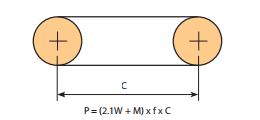Introduction
A careful assessment on the conditions surrounding a conveyor is important for exact conveyor chain choice. This segment discusses the essential concerns essential for thriving conveyor chain selection. Roller Chains are often used for light to reasonable duty materials managing applications. Environmental ailments may perhaps need the usage of specific materials, platings coatings, lubricants or the capacity to operate devoid of more external lubrication.
Primary Facts Required For Chain Choice
? Type of chain conveyor (unit or bulk) such as the process of conveyance (attachments, buckets, by way of rods and so forth).
? Conveyor layout including sprocket spots, inclines (if 
? Amount of materials (M in lbs/ft or kN/m) and sort of material to get conveyed.
? Estimated weight of conveyor components (W in lbs/ft or kN/m) which include chain, slats or attachments (if any).
? Linear chain speed (S in ft/min or m/min).
? Environment through which the chain will operate such as temperature, corrosion circumstance, lubrication issue etc.
Stage one: Estimate Chain Stress
Use the formula under to estimate the conveyor Pull (Pest) and then the chain stress (Test). Pest = (M + W) x f x SF and
Test = Pest / N
f = Coefficient of Friction
SF = Speed Aspect
Stage two: Make a Tentative Chain Selection
Utilizing the Check worth, make a tentative choice by picking out a chain
whose rated working load higher compared to the calculated Test worth.These values are ideal for conveyor support and therefore are diff erent from people proven in tables with the front of your catalog which are linked to slow velocity drive chain usage.
Also to suffi cient load carrying capability generally these chains should be of the specific pitch to accommodate a preferred attachment spacing. Such as if slats are for being bolted to an attachment every one.five inches, the pitch of the chain selected will have to divide into one.5?¡À. As a result a single could use a 40 chain (1/2?¡À pitch) using the attachments each and every 3rd, a 60 chain (3/4?¡À pitch) with the attachments each and every 2nd, a 120 chain (1-1/2?¡À pitch) with the attachments each and every pitch or maybe a C2060H chain (1-1/2?¡À pitch) with the attachments just about every pitch.
Phase three: Finalize Selection – Calculate Actual Conveyor Pull
Following creating a tentative choice we need to confirm it by calculating
the real chain stress (T). To accomplish this we need to fi rst determine the actual conveyor pull (P). From your layouts shown about the correct side of this page opt for the ideal formula and determine the total conveyor pull. Note that some conveyors may be a combination of horizontal, inclined and vertical . . . in that case calculate the conveyor Pull at just about every part and include them with each other.
Step four: Calculate Maximum Chain Tension
The maximum Chain Stress (T) equals the Conveyor Pull (P) as calculated in Step three divided from the quantity of strands carrying the load (N), times the Pace Aspect (SF) shown in Table 2, the Multi-Strand Element (MSF) shown in Table 3 as well as Temperature Issue (TF) shown in Table four.
T = (P / N) x MSF x SF x TF
Phase 5: Test the ?¡ãRated Working Load?¡À of your Picked Chain
The ?¡ãRated Operating Load?¡À from the selected chain should be higher than the Greatest Chain Tension (T) calculated in Phase four over. These values are ideal for conveyor service and are diff erent from individuals proven in tables with the front of the catalog which are associated with slow velocity drive chain usage.
Stage 6: Test the ?¡ãAllowable Roller Load?¡À with the Selected Chain
For chains that roll within the chain rollers or on best roller attachments it really is required to verify the Allowable Roller Load?¡À.
Note: the Roller load is determined by:
Roller Load = Wr / Nr
Wr = The total fat carried by the rollers
Nr = The number of rollers supporting the excess weight.